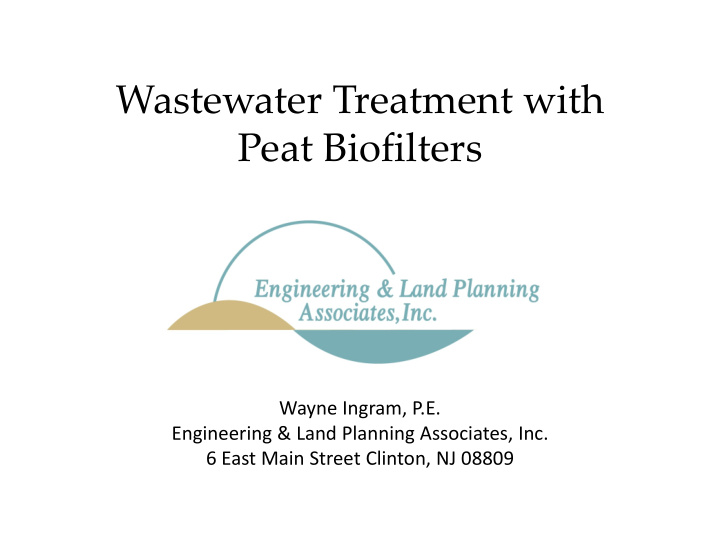



Wastewater Treatment with Peat Biofilters Wayne Ingram, P.E. Engineering & Land Planning Associates, Inc. 6 East Main Street Clinton, NJ 08809
Presentation Overview • What is Peat? • Treatment Process • Advantages • Case Studies • Design Considerations • Certification Programs • Maintenance Requirements
What is Peat?
What is Peat? Peat is an accumulation of partially decayed organic matter, which is formed under anaerobic conditions. It has been laid down in layers over time. Peat has a high capacity to bind and retain water. Peat provides long retention time within the modules allowing slow filtration of the effluent. It is a very durable media with long life expectancy.
Handful of Milled Peat
What is Peat? • Filtration media which provides treatment via physical filtration, adsorption, and microbiological activity • Biofilters create a microbial eco ‐ system in an aerobic environment • Used in the form of peat moss or peat fibers • Significant Treatment Capabilities
Biology of a Peat Biofilter Earthworms Nematodes Rotifers ‐‐‐‐‐‐‐‐‐‐‐‐‐‐‐‐‐‐‐‐‐‐‐‐‐‐‐‐‐‐‐‐‐‐‐‐‐ Protozoans and Algae ‐‐‐‐‐‐‐‐‐‐‐‐‐‐‐‐‐‐‐‐‐‐‐‐‐‐‐‐‐‐‐‐‐‐‐‐‐‐‐‐‐‐‐‐‐‐‐ Bacteria and Fungi
Treatment Capabilities Eco ‐ pure Puraflo Ecoflo BOD 90 ‐ 97% 96%+ 95% TSS 92 ‐ 98% 95%+ 90% Bacteria 99.99% 99.9%+ 99%+ • High rate of contaminant removal allows for reduced disposal bed zone of treatment
NJDEP Approved Manufacturers
• Individual biofilter per bedroom (scalable) • Uses loose peat fibre • Comes fully assembled
• One biofilter handles a four bedroom house (650 gallons) • Uses peat pillows with loose peat filling voids • Fully encapsulated water tight unit • 300 Series Biofilter Units
Ecoflo Biofilter • One biofilter handles a four bedroom house (650 gallons) • Uses peat pillows with loose peat filling voids • Unit comes open or closed bottom • ST ‐ 500, STB ‐ 500, ST ‐ 650, & STB ‐ 650 Units
When is a Peat Biofilter Advantageous? • High water table areas (<4’) • Small or oddly shaped lots • Poor or no passing percolation test • Well setbacks can not be maintained • “Green Design”
Use of Peat Biofilter Allows: • Reduction of a traditional zone of treatment of 48” to 18” (typical) • Reductions in plan view field size up to 15 ‐ 28% depending on site conditions
Typical Installation Biofilter Modules (1 per bedroom) Pump Tank Septic Tank Panel Effluent Filter
Eco ‐ pure Install
Layout of Ecopure 300 Biofilter Unit
Traditional Mounded System
Reconstructed Peat Biofilter System
Provides Guidance for: • Design • Installation • Operations & Maintenance • Reporting
Disposal Field Sizing Requirements
Design Elements • All tanks to be tested watertight • Only single piece water tight biofilters may be installed within the watertable • Design engineer must notify NJDEP within 24 hours of design submittal • All designs shall include an effluent filter
Design Elements • Pump system to biofilter pump doses ~30 gallons on a regulated and timed dosing • Pump tank operates with 2 floats
Example #1 • Exist. 3 bedroom residence on 0.6 acres • 10% site slopes • Seasonal high groundwater at 12” • Machine Refusal at 5 ‐ 8’ • Minimal permeability
Example #2 • Exist. 3 bedroom residence on 0.5 acres • Property bisected by wetland ditch • Seasonal high groundwater at 24” • Machine Refusal at 5.5’
Example #3 • Exist. 3 bedroom residence on 1.7 acres • Seasonal high groundwater at 24” • Passing Permeability at 14’ • Preserved significant area of trees • Resulted in cost savings of over $6,000
Completed System
Certification • Design engineers and installers must be licensed • Certification process is different for all three manufacturers • Contact manufacturer’s representative for licensure information
Maintenance • Between property owner and Manufacturer’s representative • Covers Normal Routine Maintenance • Required to have active agreement for the life of the system • NJDEP requires two maintenance visits per year (after initial 30 day check ‐ up)
Inspection Requirements • Wastewater level in the tanks, • Any effluent/pump filter for clogging, • Clarity in NTU's • Final effluent for odor
Inspection Requirements • All tanks for oily film or foam • pH of final effluent • Ponding of effluent around a peat biofilter treatment system or dispersal area • For pump systems, all meter readings from the control panel.
Reporting Requirements • Number of peat biofilter treatment systems installed • The address of each installed peat biofilter treatment system, the owners name and address, the type of use • Date when a peat biofilter treatment system was installed and started up • Administrative authority and permit number • Status of the maintenance and monitoring contract • Number of inspection/maintenance calls conducted
Reporting Requirements • The inspection results recorded on a Department approved inspection form and/or checklist, copies of which shall be made available by the peat biofilter manufacturer. The forms must be completed by a peat biofilter treatment system service provider and submitted to the Department upon written request. • General summary of the results for the year, all known problems or failures with a brief summary of the cause and remedial measures taken. • Any recommended changes to the design, installation and/or operation and maintenance procedures and a schedule for implementing those changes.
New Jersey Septic Management phone: (908) 874 ‐ 4669 www.nj ‐ septic.com Flemington Precast phone: (908) 782 ‐ 3246 www.flemingtonprecast.com T.P. Trezza Contracting, Inc. phone: (800) 238 ‐ 0411 www.tptrezza.com Ecoflo
Questions? Wayne Ingram, P.E. Engineering & Land Planning Associates, Inc. 6 East Main Street Clinton, NJ 08809 (908) 238 ‐ 0544 wingram@elp ‐ inc.com
Recommend
More recommend